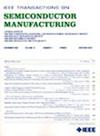BDSD-Net: An Efficient and High-Precision Anomaly Detector for Real-Time Semiconductor Wafer Vision Inspection
IF 2.3
3区 工程技术
Q2 ENGINEERING, ELECTRICAL & ELECTRONIC
引用次数: 0
Abstract
The advancement of integrated circuit fabrication processes has resulted in a concomitant increase in the complexity and frequency of surface defects on semiconductor wafers. This underscores the necessity for precise, real-time quality monitoring and control to enhance yield, cost-efficiency, and performance. Traditional automatic optical inspection (AOI) methods based on die-to-golden sample, die-to-die, or general deep learning-based semantic segmentation models often fail to meet these requirements due to insufficient detection accuracy, high false alarm rates, or inadequate throughput. To address these challenges, this paper proposes BDSD-Net, an efficient real-time detector that achieves state-of-the-art (SoTA) performance in wafer surface defect detection. Initially, a novel lightweight MVHNet backbone is developed, which seamlessly integrates the synergistic strengths of convolutional neural networks (CNNs) and Transformers within a ResNet-inspired architecture. Subsequently, an adaptive hybrid encoder is engineered to reduce the interference caused by intricate background patterns, thereby enhancing the accuracy of defect segmentation. This encoder includes an adaptive intra-scale feature interaction (ADFI) module that extracts more detailed high-level semantic information, and an adaptive multi-scale feature fusion (AMFF) module that effectively merges defect features across various scales. Moving away from high-complexity encoder structures, an efficient multi-scale residual fusion (EMRF) module is developed to narrow down the hypothesis space, thereby accelerating convergence. Finally, a knowledge distillation training strategy is also implemented to equip the lightweight model with the learning capabilities of more complex network models, thus enhancing its mean average precision (mAP) and frames per second (FPS) in inspection tasks. Extensive experimental results demonstrate the effectiveness of our method with data volume robustness, which achieves 88.2% and 88.9% mAP@0.5 on the semiconductor wafer and chip datasets. Moreover, compared to SoTA methods, our framework shows superior performance, achieving a compact model size of only 27 MB and a detection speed of 108.4 FPS. The demo code of this work is publicly available atBDSD-Net:用于半导体晶圆视觉实时检测的高效高精度异常检测器
集成电路制造工艺的进步导致了半导体晶圆表面缺陷的复杂性和频率的增加。这强调了精确、实时的质量监测和控制的必要性,以提高产量、成本效益和性能。传统的基于模对金样本、模对模或基于深度学习的语义分割模型的自动光学检测(AOI)方法往往由于检测精度不足、虚警率高或吞吐量不足而无法满足这些要求。为了应对这些挑战,本文提出了BDSD-Net,一种高效的实时检测器,在晶圆表面缺陷检测中实现了最先进的(SoTA)性能。最初,开发了一种新型轻量级MVHNet骨干网,它将卷积神经网络(cnn)和变压器的协同优势无缝集成在resnet启发的架构中。随后,设计了一种自适应混合编码器,以减少复杂背景图案的干扰,从而提高缺陷分割的准确性。该编码器包括一个可提取更详细的高级语义信息的自适应尺度内特征交互(ADFI)模块和一个可有效合并不同尺度缺陷特征的自适应多尺度特征融合(AMFF)模块。针对高复杂度的编码器结构,提出了一种有效的多尺度残差融合(EMRF)模块来缩小假设空间,从而加快收敛速度。最后,采用知识蒸馏训练策略,使轻量化模型具备更复杂网络模型的学习能力,从而提高其检测任务的平均精度(mAP)和帧数每秒(FPS)。大量的实验结果证明了我们的方法在数据量稳健性方面的有效性,在半导体晶圆和芯片数据集上分别达到了88.2%和88.9% mAP@0.5。此外,与SoTA方法相比,我们的框架表现出更优越的性能,实现了仅27 MB的紧凑模型大小和108.4 FPS的检测速度。这项工作的演示代码可在https://github.com/Adiao2001/BDSD-Net/上公开获得。
本文章由计算机程序翻译,如有差异,请以英文原文为准。
求助全文
约1分钟内获得全文
求助全文
来源期刊

IEEE Transactions on Semiconductor Manufacturing
工程技术-工程:电子与电气
CiteScore
5.20
自引率
11.10%
发文量
101
审稿时长
3.3 months
期刊介绍:
The IEEE Transactions on Semiconductor Manufacturing addresses the challenging problems of manufacturing complex microelectronic components, especially very large scale integrated circuits (VLSI). Manufacturing these products requires precision micropatterning, precise control of materials properties, ultraclean work environments, and complex interactions of chemical, physical, electrical and mechanical processes.
 求助内容:
求助内容: 应助结果提醒方式:
应助结果提醒方式:


